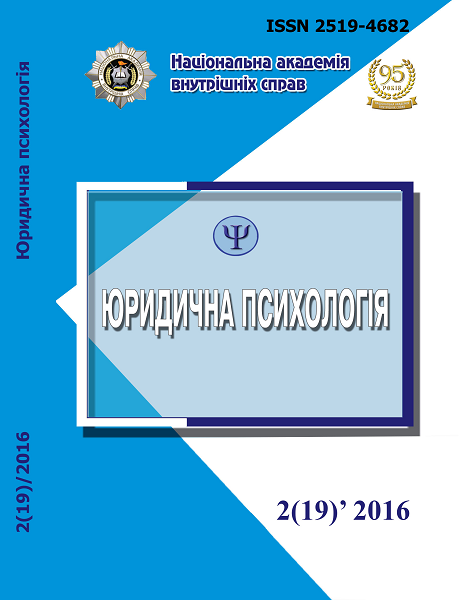Problem of Personality Structure in Psychology
Keywords:
personality, structure of personality, substructures of personality, directedness, character, abilities, temperament, consciousness, internal world, psychic condition
Abstract
Problem of the personality structure in psychology has been analyzed. Tendency to create a systemic multi-dimensional psychological structure of personality is marked. Personality structures by A. G. Kovalev, K. K. Platonov, S. D. Maximenko and S. A. Mula, V. V. Rybalko that are most widely used in domestic psychology science and practices and which are referred to as one-dimensional, two-dimensional and three-dimensional are presented; meaning content of the most important components of the personality is revealed. The personality is regarded as a socio-psychological essence of the man that results from acceptance of the mankind`s experience. In a more wide sense the personality is defined as a self-controlling systemic formation that consists of socially significant mental properties that provide selectivity in relations and regulation of man behavior as a subject of activities. Revealing of the personality essence as some integrity that has a certain structure and determining of its composition are requirements for effective psychological-pedagogical activities in realization of personality approach. It is noted that the personality structure proposed by A. G. Kovalev is one of the most established definitions in psychology theory. It is regarded as one-dimensional and consists of such structural components as: directedness, character, ability, temperament, control system («myself», that is consciousness). As two-dimensional there are regarded personality structures by K. K. Platonov and later ones by S. D. Maximenko and S. A. Mula; as a three-dimensional one – structure by V. V. Rybalko. According to K. K. Platonov the personality consists of a dynamic functional structure; it includes a substructure of directedness, experience substructure, reflection pattern substructure and biologically conditioned substructure. That is the first dimension or level of properties in the personality structure; the second consists of character and abilities. According to S. D. Maximenko and S. A. Mula the personality consists of five substructures – biopsychic, individual peculiarities of psychic processes, experience, directedness, abilities (the first dimension) and three personal, dynamically changeable common qualities – inner world, character, psychic condition (the second dimension). The personality structure by V. V. Rybalko, referred to as three-dimensional one, consists of dimensions as follows: socio-psychological-individual (the first dimension), activity (the second dimension) and genetic (the third dimension) that are filled with certain components.Downloads
Download data is not yet available.
Abstract views: 415 PDF Downloads: 6780
Issue
Section
Theoretical and methodological issues of legal psychology
- Authors reserve the right to authorship of their own work and transfer to the magazine the right of the first publication of this work under the terms of the Creative Commons Attribution License, which allows other persons to freely distribute published work with mandatory reference to authors of the original work and the first publication of an article in this magazine.
- Authors have the right to enter into separate additional agreements on non-exclusive dissemination of the work in the form in which it was published in the journal (for example, to post an article in the institution's repository or to publish as part of a monograph), provided that the link to the first publication of the work in this journal is maintained.
- The journal's policy allows and encourages the posting of articles by authors on the Internet (for example, in electronic storehouses of institutions or on personal websites), both before the submission of this manuscript to the editorial office and during its editorial processing, as this contributes to the creation of a productive scientific discussion and positively affects the efficiency and dynamics of citing the published work.




